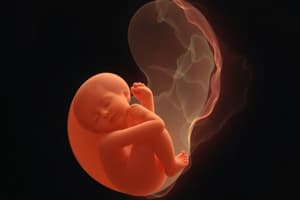Podcast
Questions and Answers
For natural mating, one rooster is usually required to mate 10 to 12 hens. With artificial insemination, one rooster can produce enough sperm to inseminate 60 to 100 females weekly. This shows that artificial insemination is more __________.
For natural mating, one rooster is usually required to mate 10 to 12 hens. With artificial insemination, one rooster can produce enough sperm to inseminate 60 to 100 females weekly. This shows that artificial insemination is more __________.
efficient
Semen should be placed about 0.75 to 1.0 inches into the everted vagina of the hen. Raw semen is most __________.
Semen should be placed about 0.75 to 1.0 inches into the everted vagina of the hen. Raw semen is most __________.
effective
Fertility can be higher from artificial insemination than from natural mating once the technique has been __________.
Fertility can be higher from artificial insemination than from natural mating once the technique has been __________.
mastered
Fertility of breeder hens as affected by time of artificial insemination. Influence of sperm number per insemination on fertility and __________.
Fertility of breeder hens as affected by time of artificial insemination. Influence of sperm number per insemination on fertility and __________.
Fertility of breeder hens inseminated at various times relative to occurrence of oviposition. Fewer Males Needed. For natural mating, one rooster is usually required to mate 10 to 12 hens. With artificial insemination, one rooster can produce enough sperm to inseminate 60 to 100 females __________.
Fertility of breeder hens inseminated at various times relative to occurrence of oviposition. Fewer Males Needed. For natural mating, one rooster is usually required to mate 10 to 12 hens. With artificial insemination, one rooster can produce enough sperm to inseminate 60 to 100 females __________.
Males should be ejaculated about three times weekly. Fertility will not be impaired by ejaculating the males as frequently as once per day. Semen volume will be lower when semen is collected more __________.
Males should be ejaculated about three times weekly. Fertility will not be impaired by ejaculating the males as frequently as once per day. Semen volume will be lower when semen is collected more __________.
Freezing semen and thawing will reduce the number of viable sperm by about one-half, and fertility will be reduced to 20%. Thawed semen must be deposited directly into the __________ to achieve this level of fertility.
Freezing semen and thawing will reduce the number of viable sperm by about one-half, and fertility will be reduced to 20%. Thawed semen must be deposited directly into the __________ to achieve this level of fertility.
Increased cost of keeping hens and roosters in cages. More cost-efficient in meat-type than in egg-type chickens. Very useful tool in commercial poultry breeding. Increased Cost Is the Deterrent. Costly due to increased labor and equipment requirements. One man-hour to collect the semen from 90 to 120 males. About 150 to 200 hens can be inseminated per __________.
Increased cost of keeping hens and roosters in cages. More cost-efficient in meat-type than in egg-type chickens. Very useful tool in commercial poultry breeding. Increased Cost Is the Deterrent. Costly due to increased labor and equipment requirements. One man-hour to collect the semen from 90 to 120 males. About 150 to 200 hens can be inseminated per __________.
Semen Storage. Survivability of avian semen in vitro is very poor due to the temperature differential of the hen's body and ambient temperature. Immediate usage of raw semen or semen mixed with diluents. New diluents show hope of extending the viability during storage beyond 24 hours. Insemination must quickly follow semen collection for the best viability. Inseminations should be done within 30 minutes of collection for best __________.
Semen Storage. Survivability of avian semen in vitro is very poor due to the temperature differential of the hen's body and ambient temperature. Immediate usage of raw semen or semen mixed with diluents. New diluents show hope of extending the viability during storage beyond 24 hours. Insemination must quickly follow semen collection for the best viability. Inseminations should be done within 30 minutes of collection for best __________.
Pre-Oviposital Embryonic Development. On average, the total incubation process requires 22 days. One day in the hen and 21 days in the incubator. Fusion of the male and female gametes occurs in the oviduct, forming the zygote. Five hours later the zygote enters the isthmus portion of the oviduct. First cleavage (incomplete cellular division) takes place, producing two, incompletely separated, daughter cells. Nuclei of the two daughter cells divide and the incomplete cleavage furrows result in four partially separated cells. Cells of the lower layer have a higher yolk content. The third cell layer, the mesoderm, will later come to occupy the space between these two. Organization of the primitive streak foreshadows the future orientation of the embryo, i.e., anterior/posterior, right / __________.
Pre-Oviposital Embryonic Development. On average, the total incubation process requires 22 days. One day in the hen and 21 days in the incubator. Fusion of the male and female gametes occurs in the oviduct, forming the zygote. Five hours later the zygote enters the isthmus portion of the oviduct. First cleavage (incomplete cellular division) takes place, producing two, incompletely separated, daughter cells. Nuclei of the two daughter cells divide and the incomplete cleavage furrows result in four partially separated cells. Cells of the lower layer have a higher yolk content. The third cell layer, the mesoderm, will later come to occupy the space between these two. Organization of the primitive streak foreshadows the future orientation of the embryo, i.e., anterior/posterior, right / __________.




